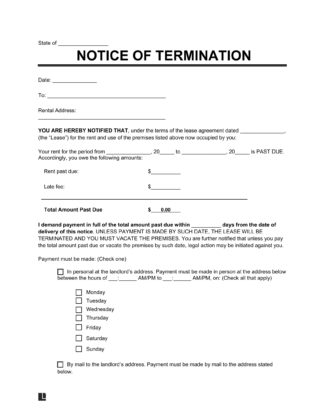
Use our Eviction Notice templates to remove a tenant from your rental property.

Updated August 22, 2024
Written by Jana Freer | Reviewed by Susan Chai, Esq.
An eviction notice is a legal document a landlord sends to tenants to inform them that they must fix a particular problem or vacate the property within a certain number of days. This notice informs tenants of the issue and demands corrective action or vacating the property within a set period.
If you are a tenant who needs to let your landlord know you want to move out, consider sending a notice to vacate.
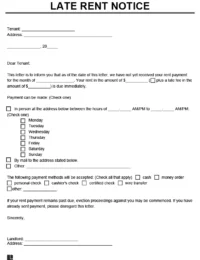
Use it to let a tenant know rent is late and encourage them to pay.
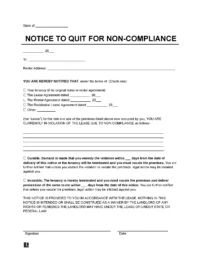
Sent by a landlord when a tenant commits a lease violation other than late rent.
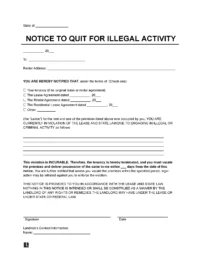
Informs the tenant they must vacate the property because they committed an unlawful act.
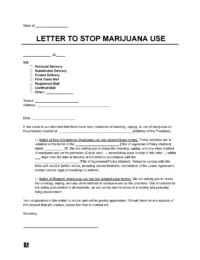
Warns a tenant to stop smoking marijuana and states the consequences if they fail to do so.
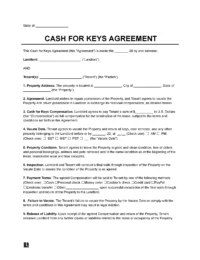
Creates an agreement where the tenant receives a cash payment if they voluntarily vacate the property.
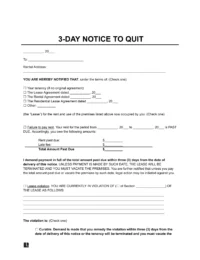
Informs tenants they have three days to fix a lease violation or move out.
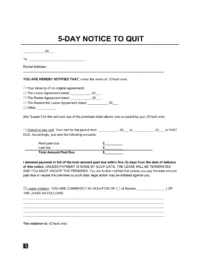
Commonly issued for non-payment of rent but applicable to any lease violation.
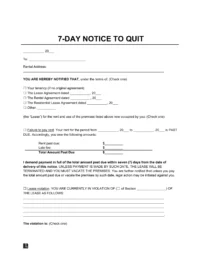
Grants the tenant a seven-day window to address the violation; failure to comply or vacate may prompt eviction proceedings.
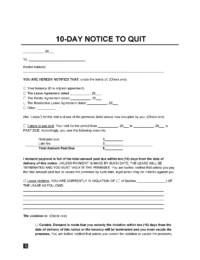
Notifies a tenant of overdue payments or lease agreement violations, allowing them the option to rectify the situation or vacate the premises within ten days.
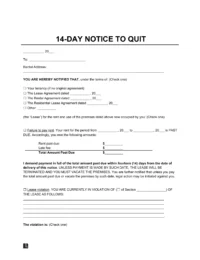
Allows a tenant to rectify a lease violation or vacate the property. Repeated breaches within a specified period may grant the landlord the option to terminate the agreement.
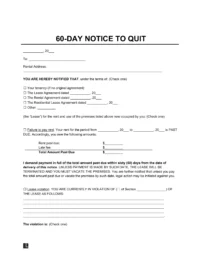
Typically issued by a landlord to terminate a month-to-month tenancy.
An eviction notice (or eviction letter) is a legal document used by a landlord to evict a tenant who fails to comply with the original terms of the lease or rental agreement.
In some cases, the landlord may believe the problem is not fixable and send an incurable notice. In the case of an incurable eviction notice, the tenant has no choice but to vacate the property within a certain number of days.
Even if the landlord serves the notice, the tenant has the right to stay on the premises until a judge hears from the landlord and tenant.
A landlord needs a court order before evicting a tenant. Suppose tenants do not voluntarily vacate or move out. In that case, a sheriff or other law enforcement officer may forcibly remove them and their belongings even after the judge issues an official court order.
Most states give a “Tenant at Will” more protection than a “Tenant at Sufferance.”
A tenant usually stays on the premises with the landlord’s permission, so states often give such tenants more advanced notice (i.e., 30-day notice).
In contrast, a tenant at sufferance (i.e., a holdover tenant) stays on the premises without the landlord’s permission and gets less time for a landlord to begin an eviction (i.e., usually, no advanced notice is required).
Here’s an easy-to-understand chart describing the differences:
| Tenant at Will | Tenant at Sufferance |
|---|---|
| Landlord permission given | Landlord does NOT give permission |
| Month-to-month lease (written or verbal) | Landlord ends month-to-month lease |
| Invalid lease (i.e. no rent amount) | Landlord sends a Notice to Quit |
| Written lease ended or expired BUT 1. Landlord accepts your rent 2. No new lease has been signed | Written lease ended or expired and 1. Landlord wants Tenant out 2. Landlord does not accept rent or accept rent under protest (AKA "Holdover Tenant") |
| No expiration date or last day of rent |
The following example records a notification given by the landlord, Sarah R Cooper, to the tenant, Margaret A Burgess. Sarah R Cooper wishes to inform Margaret A Burgess that the lease is terminated and that Margaret needs to leave the premises.
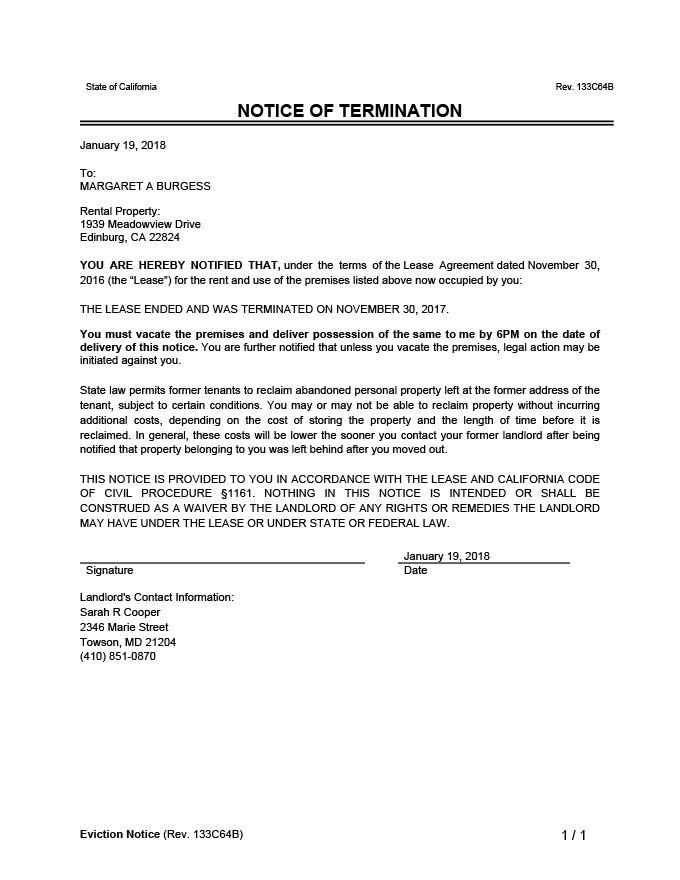
Use the table below to find out which type of notice you need to provide based on state-specific applicable periods and laws:
| State | Notice Period - Non-Payment | Notice Period - Non- Compliance | Pay to Avoid Eviction ( if curable ) | Law |
|---|---|---|---|---|
| Alabama | 7 days | 7 days | Yes | § 35-9A-421 |
| Alaska | 7 days | 10 days | Yes | § 34-3-160, § 34-3-220 |
| Arizona | 5 days | 10 days | Yes | § 33-1368 |
| Arkansas | 3 days | 14 days | No | § 18-60-304, § 18-17-901 |
| California | 3 days | 3 days | Yes | Code of Civil Procedure 1161 |
| Colorado | 10 days | 10 days | Yes | § 13-40-107, § 13-40-104 |
| Connecticut | 3 days | 15 days | No | § 47a-23 |
| Delaware | 5 days | 7 days | Yes | Title 25, Chapter 55 § 5513, Title 25, Chapter 55 §5502 |
| Florida | 3 days | 7 days | Yes | § 83.56 |
| Georgia | Immediate | N/A | Yes | § 44-7-50 |
| Hawaii | 5 days | 10 days | Yes | § 521-72, § 521-68 |
| Idaho | 3 days | 3 days | Yes | § 6-303 |
| Illinois | 5 days | 10 days | Yes | 735 ILCS 5/9-210, 735 ILCS 5/9-209 |
| Indiana | 10 days | N/A | Yes | § 32-31-1-6 to § 32-31-1-9 |
| Iowa | 3 days | 7 days | Yes | § 562A.27 |
| Kansas | 3 days | 14 days | Yes | § 58-2564, § 58-2507 |
| Kentucky | 7 days | 14 days | Yes | § 383.665, § 383.660 |
| Louisiana | 5 days | 5 days | No | CCP 4701 |
| Maine | 7 days | 7 days | Maybe | Chapter 710, Title 14 § 6002 |
| Maryland | 10 days | 30 days | Yes | § 8-401 to 8-402 |
| Massachusetts | 14 days | 30 days | Yes | Chapter 186, Section 11, 11A |
| Michigan | 7 days | 7 days | Yes | § 600.5714, § 554.134 |
| Minnesota | 14 days | N/A | Yes | § 504B.135 |
| Mississippi | 3 days | 14/30 days | Yes | § 89-7-27, § 89-8-13 |
| Missouri | Immediate | 10 days | Yes | § 441.040, § 535.060 |
| Montana | 3 days | - 14 days - 3 days if pet or guest problem | Yes | § 70-24-422 |
| Nebraska | 7 days | - 14 days to cure - 30 days to vacate | Yes | § 76-1431 |
| Nevada | 5 days | 5 days | Yes | § 40.2512 |
| New Hampshire | 7 days | 30 days | Yes | § 540:3 |
| New Jersey | 30 days | 30 days | Yes | N.J.S.A. 2A:18-53 |
| New Mexico | 3 days | 7 days | Yes | § 47-8-33 |
| New York | 14 days | 30 days | Yes | § 711, § 753 |
| North Carolina | 10 days | Immediate | Yes | § 42-3 |
| North Dakota | 3 days | 3 days | Yes | § 47-32 |
| Ohio | 3 days | 3 days | Yes | § 1923.02, § 1923.04 |
| Oklahoma | 5 days | - 10 days to cure - 15 days to vacate | Yes | Title 41 § 41-131, 132 |
| Oregon | 3 days | - 10 days to cure - 14 days to vacate | Yes | ORS 90.392, 90.394 |
| Pennsylvania | 10 days | - 15 days - 30 days if tenant has lived there for over one year | Yes | Landlord Tenant Act Section 501 |
| Rhode Island | 5 days | 20 days | Yes | § 34-18-36, §34-18-35 |
| South Carolina | 5 days | 14 days | Yes | § 27-40-710 |
| South Dakota | 3 days | Appropriate notice period | No | § 43-32-18, § 21-6-2 |
| Tennessee | 14 days | - 14 days to cure - 30 days to vacate | - 14 days: yes - 7 days: no | § 66-7-109, § 66-28-505 |
| Texas | 3 days | 3 days | No | § 24.005 |
| Utah | 3 days | 3 days | Yes | Title 78B Chapter 6 § 802 |
| Vermont | 14 days | 30 days | Yes | 9 V.S.A. § 4467 |
| Virginia | 5 days | - 21 days to cure - 30 days to vacate | Yes | § 55.1-1245, § 55.1-1415 |
| Washington | 14 days | 10 days | Yes | § 59.12.030 |
| West Virginia | Immediate | Immediate | Yes | Chapter 55 Article 3A |
| Wisconsin | 5/14 days | 5/30 days | - 5 days: yes - 14 days: no | § 704.17 |
| Wyoming | 3 days | 3 days | Yes | § 1-21-1003 |
| Show More Show Less | ||||
The tenant has a certain number of days (check your local housing laws) to pay rent or leave.
For example, imagine Steven, who is a tenant in South Dakota. His rent is due at the end of each month. August 31st comes and goes, and he misses his rent payment. His landlord can send a 3-day notice to quit for non-payment of rent, giving Steven three days to pay his rent or move out.
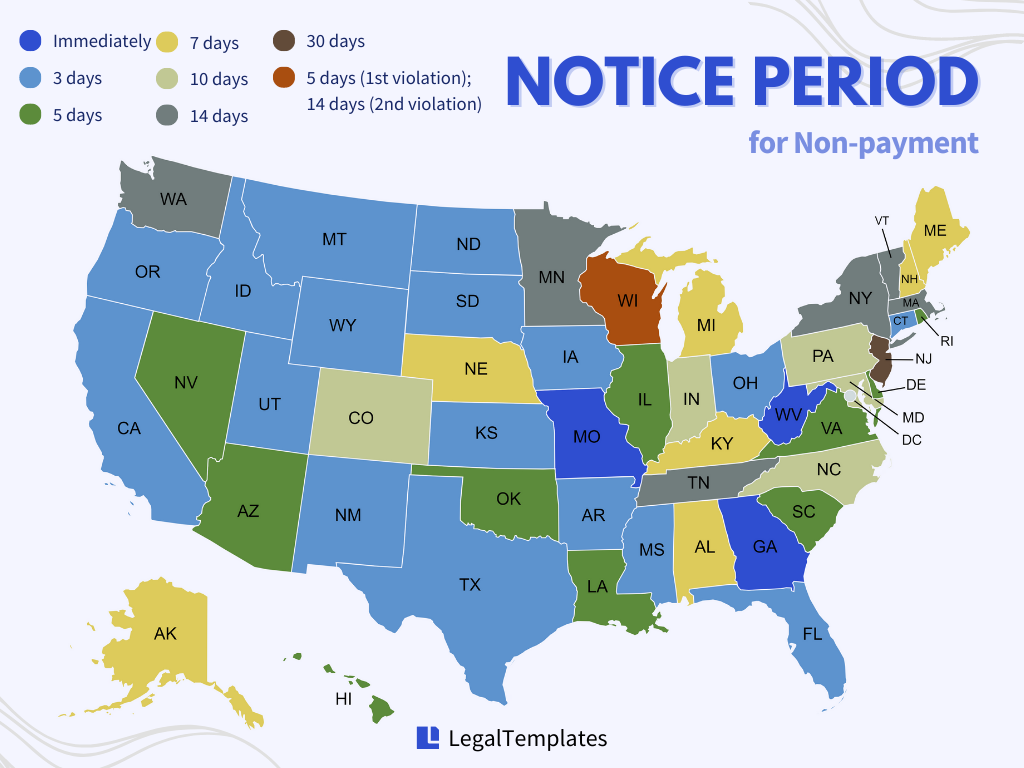
Most state eviction laws agree that tenants should pay their rent on time. More than a third of the states require landlords to give a minimum 3-day notice when rent is late or overdue, while almost a quarter of the states require a minimum of 5 days, and only six states require seven days.
Tenants have a certain amount of time to correct or “cure” a problem, such as violating a no-smoking or no-pet policy. Otherwise, they must leave or “quit” the premises.
For example, imagine Laura, who is a tenant in Vermont. Her lease has a direct clause stating that she isn’t allowed to have more than one dog. During an inspection, the landlord observes two dogs in her apartment. The landlord can issue a 30-day notice to quit for non-compliance, giving Laura 30 days to get rid of the unauthorized dog or move out.
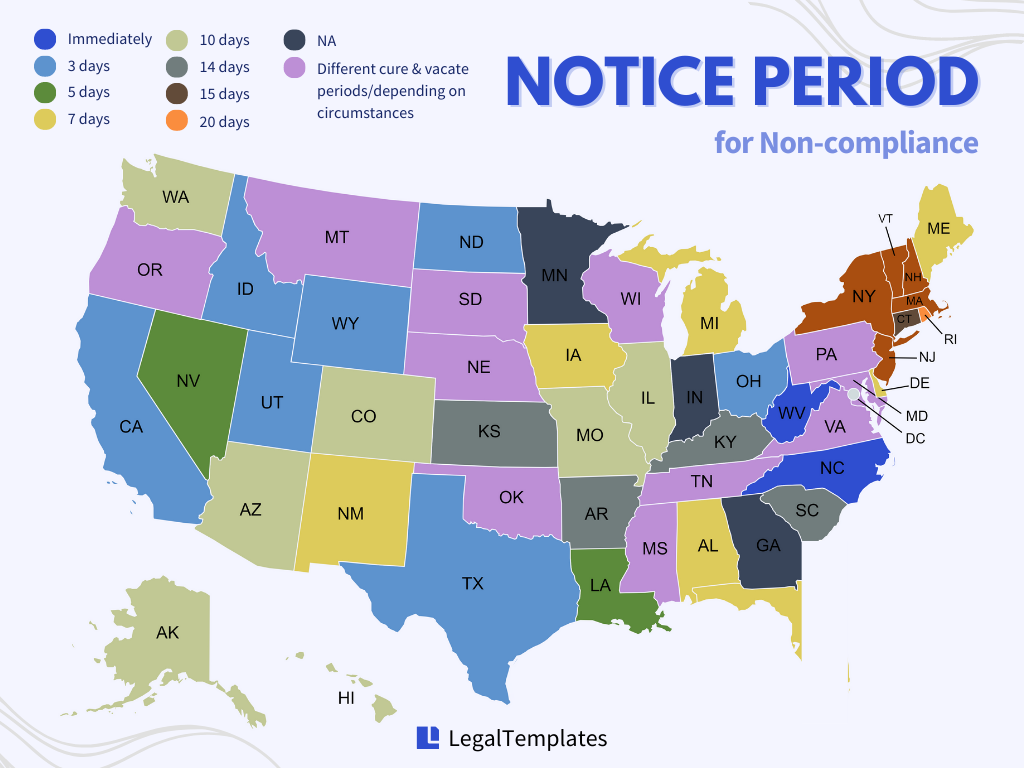
States vary widely on the minimum number of days a landlord should give tenants to cure the default (i.e., no longer violate the lease provision). Nine states require that landlords give tenants a minimum 3-day notice if a tenant has broken one of their promises in the lease agreement .
Interestingly, eight states do not require a minimum notice since the lease already spells out the obligations, and the tenant is perhaps assumed to have broken the lease knowingly.
The tenant cannot pay rent or correct the problem because, on multiple occasions, they have:
For example, consider Bradley, a tenant in South Carolina. He engages in illegal drug use on the property. His landlord can issue an immediate notice to quit for illegal activity, giving him no option to correct the breach.
Most states (more than ⅔) require only a 30-day notice to end a month-to-month or holdover tenancy, but some states, like Delaware and Georgia, provide a more tenant-friendly 60-day notice.
Landlords also use unconditional quit notices to end an unwanted landlord-tenant relationship with someone who has overstayed their lease (i.e., a Tenant at Sufferance).
Generally, the rules and regulations governing the process provide different protections for landlord and tenant due process. Neither the tenant nor the landlord can be deprived of “property” in the form of either housing (for the tenant) or rent money (for the landlord), following appropriate legal procedures and safeguards.
The eviction process is akin to an expedited lawsuit by the landlord (i.e., plaintiff) against the tenant (i.e., defendant). It ensures that both the tenant and the landlord receive fair treatment. Only the judge has the final say in whether the tenant must leave.
Other ways to refer to the eviction process include:
Usually, the eviction process is a “summary” court procedure. This means that the court will move forward with the case quickly, and the tenant has a short time to respond to the lawsuit.
Instead of waiting months for a judge to hear the case, the landlord and tenant can appear before the local court relatively soon after the landlord files a complaint.
Landlords use it to inform tenants that the eviction process is beginning. Still, landlords may not need to begin eviction if the landlord and tenant can resolve the problem themselves.
In most cases, it is desirable to avoid serving the notice to save both parties time, energy, and expense.
The following are some possible reasons for eviction:
If the tenant is late paying rent, there are several procedures a landlord can follow.
Perhaps there was a misunderstanding about the lease terms — did the tenant have a death in the family, suffer a work injury, or lose their job? Maybe the landlord is willing to work out a payment plan for missed rent payments. Would the tenant be willing to pay for the cost of repair to fix the damage caused to the premises?
Sometimes, a sincere apology, candid communication, and an honest willingness to cooperate can save the landlord and tenant time and money in the long term.
If landlords and tenants cannot resolve a disagreement, and landlords want to end the lease agreement and properly ask tenants to leave by a specific date, they should send the notice.
In the hurry to voluntarily move out, a tenant might also leave furniture and personal belongings. Before landlords sell these abandoned personal items, they should check local and state laws.
Some states require landlords to store abandoned belongings for a specific time.
In contrast, others allow landlords to sell these items, but only after contacting the tenant, posting a notice in the newspaper, or following other strict procedures.
If a landlord doesn’t follow the proper procedures, the tenant can challenge the eviction on a technicality and force the landlord to restart the process.
For example, if the landlord was required to give a 10-day notice but only gave a 3-day notice, the tenant may be able to claim that you violated their right to due process.
A landlord should consult their local housing laws and carefully follow the strict steps to evict a tenant properly.
Even if a tenant is actively damaging the premises, a landlord may NOT resort to self-help measures. Instead, if the landlord is right, the court will require the tenant to move out sooner . In most states, self-help measures are ILLEGAL.
A landlord may NOT:
The landlord MUST use the court-administered eviction process to remove the tenant from the premises.
Ultimately, only the courts have the power and authority to decide whether an eviction can legally occur.
When drafting the document, remember that it should answer: Who, Why, Where, What, and When.
Who does it apply to
Why there is the reason for an eviction
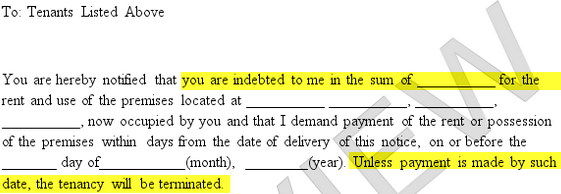
Where the eviction occurs
This is the address and location of the rental property (or “Premises”) from which the landlord is evicting the tenant. If the address applies to your type of housing, be sure to include any room or apartment number as part of the street address.

What should be done to fix the problem
When the tenant must remedy the situation
